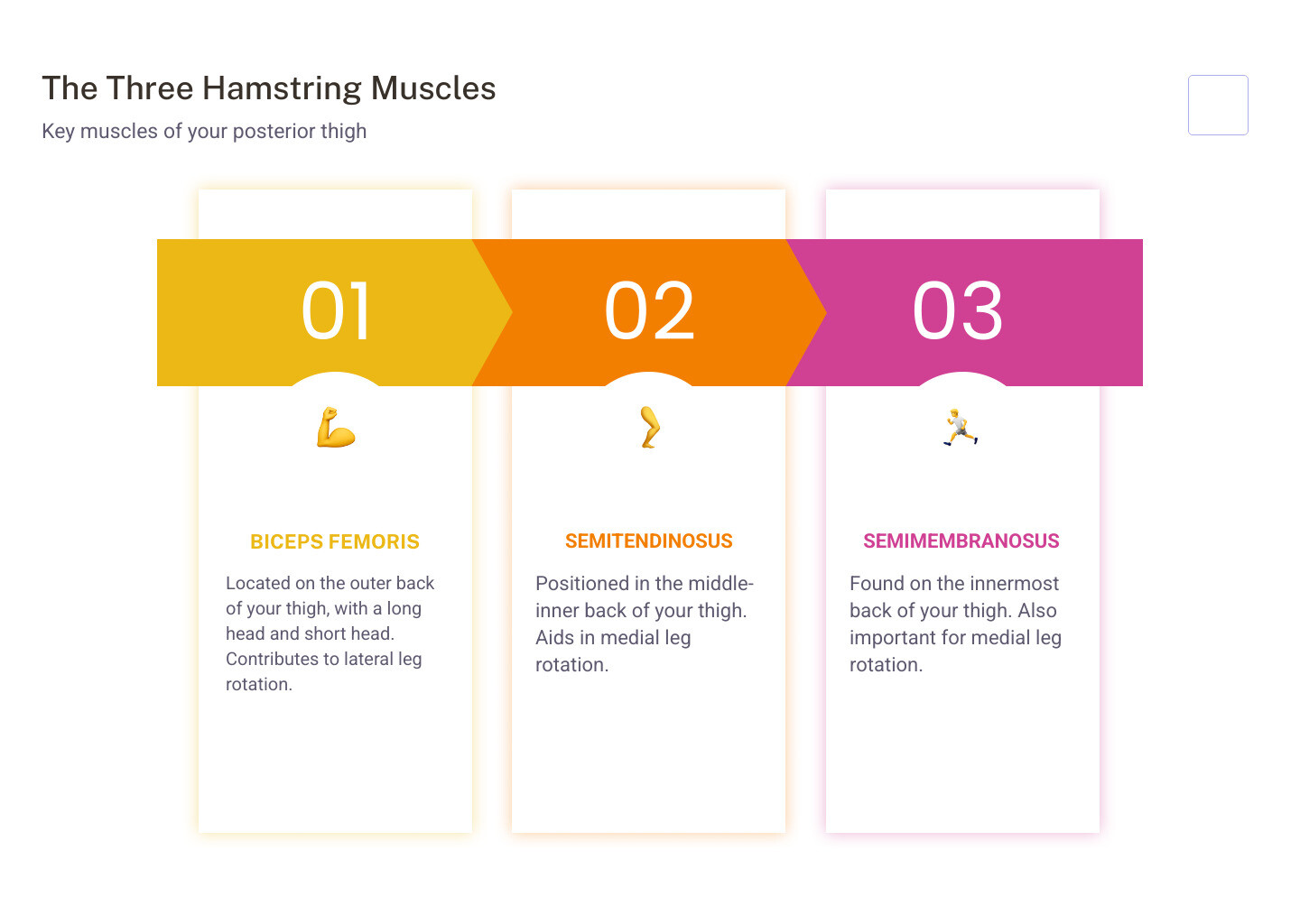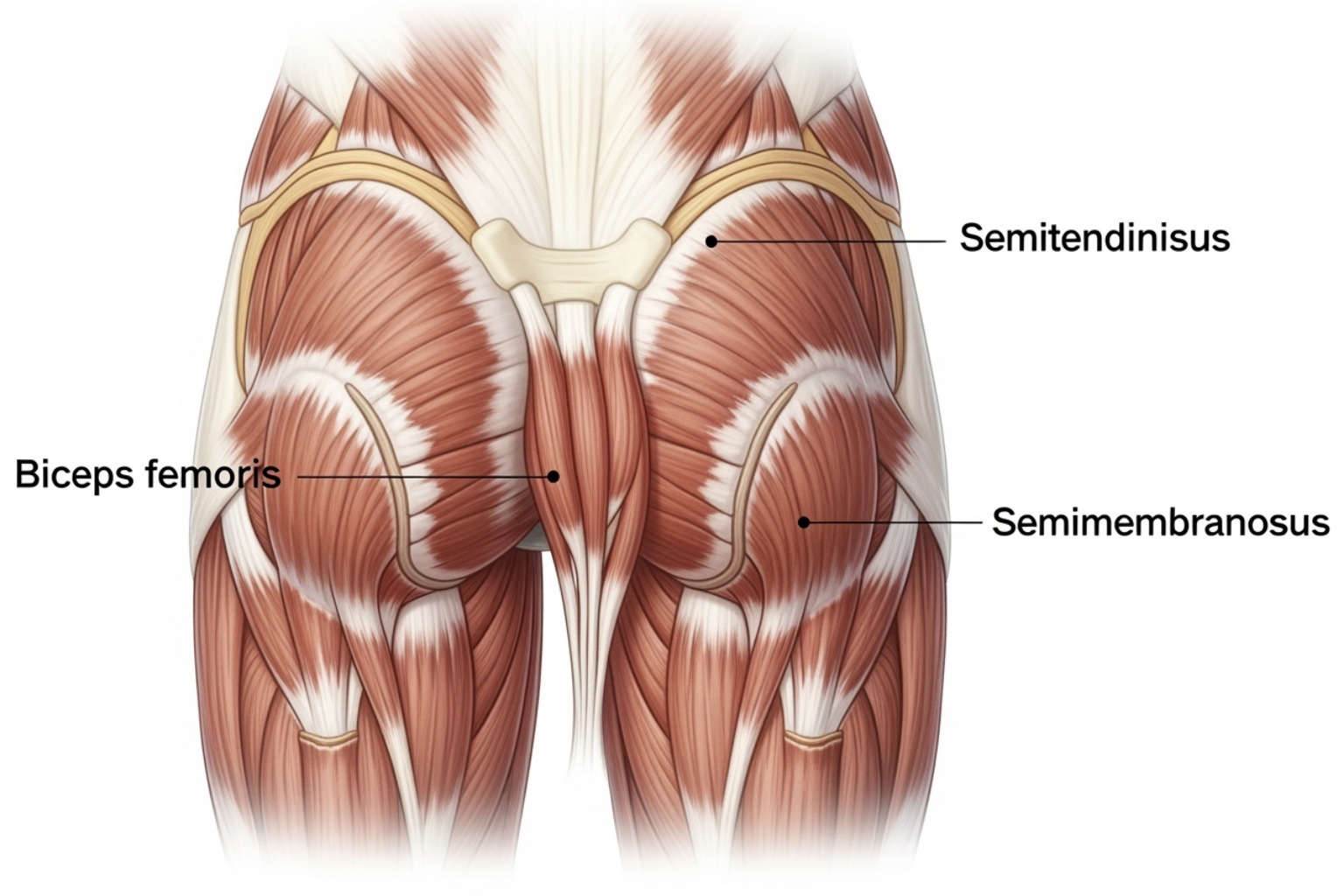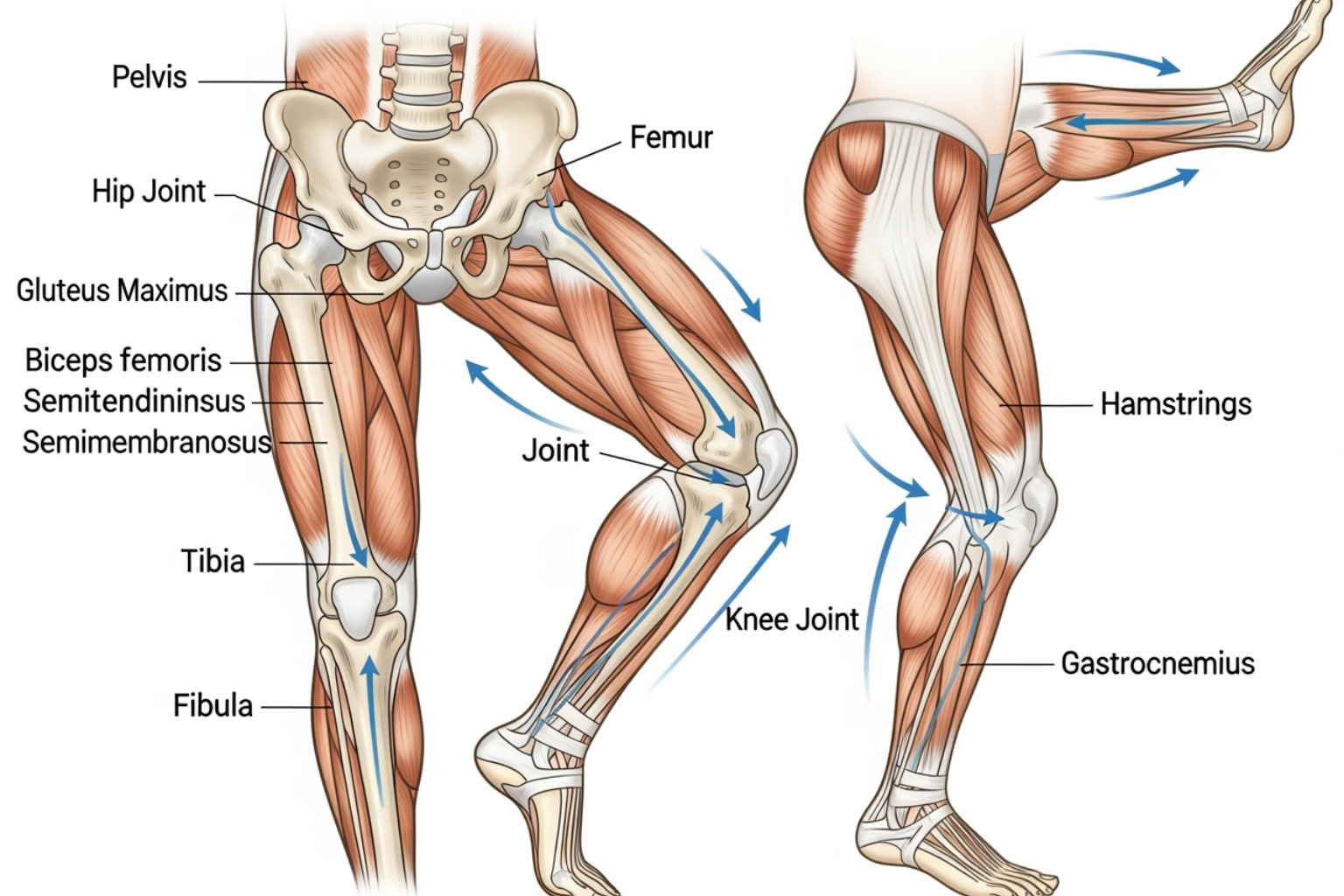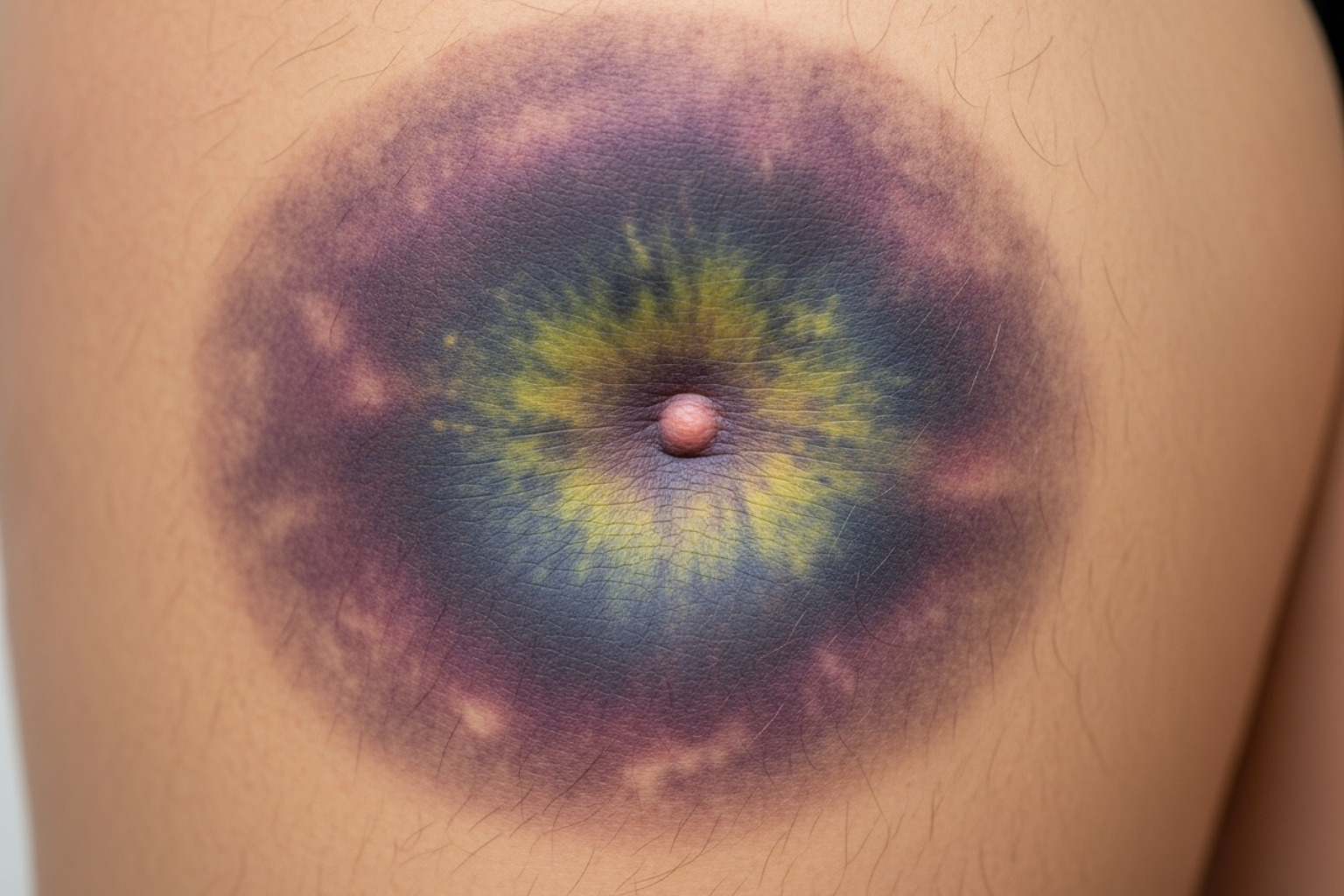Why Understanding Your Hamstring Anatomy Matters
Understanding the anatomy of hamstrings is essential for anyone serious about athletic performance, injury prevention, or recovering from thigh pain. The hamstring muscle group consists of three powerful muscles in the back of your thigh: the biceps femoris, semitendinosus, and semimembranosus. These muscles work together to bend your knee, extend your hip, and stabilize your leg.
Quick Overview: The Three Hamstring Muscles
- Biceps Femoris - Located on the outer back of your thigh.
- Semitendinosus - Positioned in the middle-inner back of your thigh.
- Semimembranosus - Found on the innermost back of your thigh.
Key Functions:
- Knee flexion (bending)
- Hip extension (moving thigh backward)
- Knee joint stabilization
- Rotation of the lower leg
Whether you're sprinting, climbing stairs, or walking, your hamstrings are constantly at work. Unfortunately, they're also one of the most commonly injured muscle groups in sports, accounting for up to 19% of all injuries in some activities [1]. Hamstring strains can sideline athletes for an average of 24 days [2], and nearly one-third of people who suffer a hamstring injury will experience a recurrence within a year [1].
Understanding how these muscles are built and how they function can help you prevent injuries and recover more effectively. This guide will walk you through everything you need to know about these powerful muscles so you can keep moving confidently.

A Deep Dive into the Anatomy of Hamstrings
Your hamstrings are powerful muscles stretching from your pelvis to your lower leg bones, located in the posterior compartment of the thigh. What makes the anatomy of hamstrings unique is that most are "biarticular," meaning they cross two joints (the hip and the knee). This design gives them versatility but also makes them vulnerable to injury.
The hamstrings receive blood from the deep femoral artery and its perforating branches. The sciatic nerve (from nerve roots L4-S3) provides the signals for contraction, splitting into the tibial nerve and common fibular nerve to control different parts of the muscle group.
The Three Muscles of the Hamstring Complex
We're really discussing three distinct muscles that work as a team. Each has its own characteristics, though they share common goals.

- The biceps femoris runs along the outer thigh and has two heads (a long head and a short head). Because the short head only crosses the knee, some experts debate if it's a true hamstring. The biceps femoris is the most frequently injured hamstring muscle [3].
- The semitendinosus is the longest of the three, sitting on the inner side of the posterior thigh. It's known for its long, cord-like tendon.
- The semimembranosus is a broad, flat muscle that lies deeper and more to the inside than the semitendinosus.
An honorary member is the hamstring portion of the adductor magnus. While its main job is adduction (pulling the leg inward), its back fibers assist with hip extension.
Detailed Anatomy of Hamstrings: Origins and Insertions
Understanding where each hamstring starts (origin) and ends (insertion) explains how they create movement. Most originate at the ischial tuberosity (your "sit bone") on the pelvis. They travel down the back of the thigh and attach to the tibia (shin bone) and fibula (smaller lower leg bone).
This setup allows them to both extend the hip and flex the knee. Here’s a breakdown:
| Muscle | Origin | Insertion | Innervation |
|---|---|---|---|
| Biceps Femoris (Long Head) | Ischial tuberosity (pelvis) | Head of the fibula (lower leg) | Tibial part of the sciatic nerve (L5, S1, S2) |
| Biceps Femoris (Short Head) | Linea aspera and lateral supracondylar line of the femur (thigh bone) | Head of the fibula (lower leg) | Common fibular part of the sciatic nerve (L5, S1, S2) |
| Semitendinosus | Ischial tuberosity (pelvis) | Medial surface of the tibia (pes anserinus) | Tibial part of the sciatic nerve (L5, S1, S2) |
| Semimembranosus | Ischial tuberosity (pelvis) | Medial tibial condyle (lower leg) | Tibial part of the sciatic nerve (L5, S1, S2) |
Anatomical Variations and Clinical Implications
Not everyone's anatomy is identical. While the three-muscle structure is standard, anatomical variations occur. Some people may have a "third head" of the biceps femoris, while rare cases of congenital absence of the semimembranosus have been documented. These variations have clinical implications, influencing surgical planning and diagnosis when symptoms don't match textbook descriptions, as detailed in research on the hamstring muscle complex [3].
The Function and Biomechanics of the Hamstring Muscles
Now that we've covered the anatomy of hamstrings, let's explore what they do. Spanning both the hip and knee, they are essential players in nearly every lower body movement.
Primary Actions: Knee Flexion and Hip Extension
Your hamstrings perform two fundamental movements. Knee flexion is the act of bending your knee, bringing your heel toward your backside. Hip extension is moving your thigh backward, which propels you forward when you walk or run.

Additionally, each hamstring muscle helps rotate your lower leg when the knee is bent. The semitendinosus and semimembranosus (inner thigh) create medial rotation (turning the lower leg inward). The biceps femoris (outer thigh) produces lateral rotation (turning the lower leg outward). These subtle rotations provide fine control for changing direction and maintaining balance.
How Hamstrings Contribute to Movement and Stability
Your hamstrings are true multitaskers. During the gait cycle (walking and running), their most critical job occurs just before your foot hits the ground. As your leg swings forward, your hamstrings perform an eccentric contraction—lengthening while contracting—to slow down the lower leg. This deceleration of the tibia acts like a brake, preventing your knee from snapping into extension and ensuring a smooth foot strike. This eccentric loading is vital for efficiency but is also why hamstring injuries are so common, as detailed in research on hamstring injury mechanisms during running [1].
Your hamstrings are also crucial dynamic stabilizers for the knee, working with the anterior cruciate ligament (ACL) to prevent the shin bone from sliding too far forward. This interaction with the ACL is vital during sudden stops, direction changes, or jumping.
Finally, hamstrings and quadriceps (front of thigh) act as antagonists. Hamstrings bend the knee and extend the hip, while quadriceps do the opposite. This balance ensures smooth movement. An imbalance, where one group is much stronger or tighter than the other, can increase injury risk. When hamstring soreness strikes from this hard work, many find relief with targeted topical solutions to soothe muscle discomfort.
Common Hamstring Injuries and Clinical Significance
The anatomy of hamstrings makes them vulnerable during explosive movements like sprinting and jumping. When these muscles are pushed beyond their limits, injuries can strike quickly and painfully.
Hamstring injuries are a major issue in sports, accounting for up to 19% of all injuries in some activities [1] and sidelining athletes for an average of 24 days [2]. The most frustrating part is the high recurrence rate: nearly one-third of people will reinjure their hamstring within a year [1]. The biceps femoris is the most frequently injured of the three [3]. For more information, the American Academy of Orthopaedic Surgeons (AAOS) provides an excellent patient resource [4].
Hamstring Strains, Tears, and Avulsion Fractures
Hamstring injuries range from mild strains to severe ruptures.
- Grade 1 Strain (Mild): Overstretched fibers cause tightness or a dull ache. You can typically walk without a limp.
- Grade 2 Strain (Partial Tear): A partial tear of muscle fibers causes sudden, sharp pain, swelling, and bruising. Walking is difficult due to pain and weakness.
- Grade 3 Strain (Complete Tear): A complete rupture of the muscle. Sufferers often report a "popping" sensation, followed by intense pain, significant swelling, and an inability to bear weight.

An avulsion fracture is a less common but severe injury where the hamstring tendon tears off the bone, taking a piece of bone with it. This most often occurs at the ischial tuberosity (sit bone) and is more common in adolescents whose growth plates are still open.
Risk Factors and Diagnosis
Several factors increase your risk of a hamstring injury:
- Muscle tightness and inflexibility
- Muscle imbalance (e.g., quadriceps much stronger than hamstrings)
- Poor conditioning or fatigue
- Previous hamstring injury
- Age (adolescents in growth spurts and older athletes)
Diagnosis begins with a physical exam to check for tenderness and assess strength. Imaging tests provide a clearer picture. X-rays can identify avulsion fractures, while MRI scans are the gold standard for visualizing soft tissue damage, showing the exact location and severity of a muscle tear.
Clinical Considerations: Hamstring Tendons and Knee Health
Beyond movement, hamstring tendons are critical stabilizers for the knee joint, working with the ACL to maintain stability. This function has made them valuable in orthopedic surgery, particularly for ACL reconstruction. Surgeons often harvest the semitendinosus tendon to create a new ligament (an autograft). This procedure has several advantages, including less donor site pain, but it's a trade-off that surgeons and patients consider carefully.
Hamstring Injury Treatment and Recovery
A hamstring injury can be a frustrating setback, but the good news is that most strains heal well with nonsurgical treatment. A smart rehabilitation plan is key to restoring function and, most importantly, preventing reinjury.
Immediate Care and Rehabilitation Strategies
In the first hours and days after an injury, follow the RICE protocol: Rest, Ice (15-20 minutes several times a day), Compression (with a bandage), and Elevation (propping the leg up). This helps control pain and swelling. For more severe tears, crutches or temporary immobilization may be needed to protect the healing muscle.
Once the acute pain subsides, physical therapy is essential. A therapist will guide you through a phased program, starting with gentle stretching to restore range of motion. This is followed by strengthening, where eccentric strengthening exercises (lengthening the muscle under tension) are especially effective for hamstring rehab. As you heal, the program will incorporate progressive agility and trunk stabilization exercises to prepare you for a safe return to sport.
Patience is critical. Rushing back too soon is a primary cause of reinjury. Our guide on hamstring strain treatment offers more specific strategies [5], and you can explore general approaches to muscle strain treatment [6] for more context.
Managing Pain and Aiding Recovery
Pain can interfere with your recovery. While rest and rehab address the injury, managing discomfort allows you to participate more fully in your physical therapy.
Topical analgesics offer targeted relief right where you need it. Formulations with ingredients like Menthol, Aloe, and Urea can provide soothing comfort. Menthol creates a cooling sensation that helps distract from pain signals, while Aloe and Urea support healthy skin and improve absorption.
Having a reliable way to ease muscle soreness makes a real difference. Many athletes and active individuals use Neuropasil to manage the discomfort that comes with rehabilitation. The targeted application means relief goes exactly where the anatomy of hamstrings needs it most. You can find natural relief for muscle pain to support your recovery journey.
Frequently Asked Questions about Hamstring Health
Understanding the anatomy of hamstrings often leads to more questions about protecting these crucial muscles. Here are answers to some of the most common ones.
Why are hamstring injuries so common in athletes?
Hamstring injuries are common in athletes due to the incredible stress placed on them during high-speed activities. When sprinting, the hamstrings must perform a powerful eccentric contraction to slow the leg down just before the foot strikes the ground. This powerful braking force, combined with the sudden stops and starts common in sports, makes the muscle fibers vulnerable to tearing. The high recurrence rate, with nearly one-third of athletes experiencing a reinjury within one year [1], makes prevention and proper rehab critical.
What is the difference between the three hamstring muscles?
Their primary difference lies in their location on the thigh, which dictates their rotational function. The biceps femoris sits on the lateral (outer) side and rotates the lower leg outward when the knee is bent. The semitendinosus and semimembranosus are on the medial (inner) side and work together to rotate the lower leg inward. These different insertion points on the lower leg bones allow for fine-tuned control during complex movements.
Can I prevent hamstring injuries?
Yes, you can absolutely take steps to reduce your risk of hamstring injuries. While no strategy is foolproof, these smart habits can make a significant difference:
- Proper Warm-Up: Always start with dynamic stretching and light movement (like leg swings and gentle jogging) to get blood flowing to the muscles.
- Regular Stretching: Maintain flexibility with static stretching after your workout when muscles are warm.
- Strengthening: Your best defense is a consistent strengthening program for the hamstrings and glutes. Eccentric exercises like Nordic hamstring curls and Romanian deadlifts are especially effective.
- Core Stability: A strong core provides a stable base for your legs, reducing stress on the hamstrings.
- Avoid Overtraining: Listen to your body. Fatigued muscles are vulnerable muscles, so build in rest days and get adequate sleep.
References
The information in this guide on the anatomy of hamstrings is based on peer-reviewed research, clinical studies, and medical institution guidelines to ensure you receive accurate, trustworthy information.
- Hamstring Injury Mechanisms in Sprinting
- Injury Incidence and Injury Patterns in Professional Football: The UEFA Injury Study
- Anatomy of the Hamstring Muscle Complex and its Injury Patterns
- Hamstring Muscle Injuries - OrthoInfo - AAOS
- Hamstring Strain Treatment: Fast Relief Tips
- Muscle Strain Treatment
Managing pain during recovery is crucial for staying on track with your rehabilitation. If you're looking for natural, topical relief to support your healing, you can Find natural relief for muscle pain with Neuropasil's targeted formula, designed to soothe sore muscles and support your active lifestyle.














